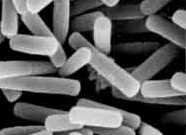 Â Helicobacter pylori are bacteria that cause chronic low-level inflammation of the stomach lining and are linked to the development of duodenal and gastric ulcers and stomach cancer.
 Helicobacter pylori are bacteria that cause chronic low-level inflammation of the stomach lining and are linked to the development of duodenal and gastric ulcers and stomach cancer.
Researchers from the College of Medicine in Seoul, South Korea added a probiotic-containing yogurt to usual therapy.
First, the details.
- 347 H pylori-infected patients were randomly assigned to 2 treatments for 7 days.
- Yogurt group: A proton pump inhibitor anti-ulcer drug + the antibiotics clarithromycin and amoxicillin + yogurt
- Usual treatment group: A proton pump inhibitor drug + the antibiotics clarithromycin and amoxicillin
- The yogurt used was a product called Will yogurt (a Korean brand) containing Lactobacillus acidophilus HY2177, Lactobacillus casei HY2743, Bifidobacterium longum HY8001, and Streptococcus thermophilus B-1.
And, the results.
- H. pylori eradication in the yogurt group (79%) was similar to the usual treatment group (72%).
- However, the rate of eradication in the yogurt group was significantly faster than in the usual treatment group.
- Side effects were metallic taste and diarrhea, and occurred significantly more often in the yogurt group (41%) vs the usual treatment group (26%).
- Most side effects were mild to moderate in intensity and similar in both groups.
The bottom line?
The results suggest that this brand a yogurt can speed the rate of response, but at the cost of more side effects.
9/10/08 21:01 JR